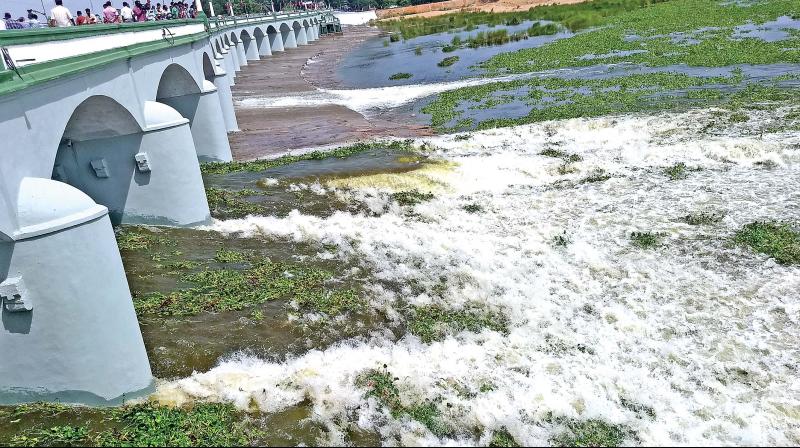Water weeds threaten to spoil Cauvery party
Agriculturists and greens are concerned that ubiquitous water hyacinth and Ipomea can eat into the efficiency of canal irrigation.

Thanjavur: People who converged at Grand Anicut in Thanjavur district to witness release of Cauvery water for ‘samba’ paddy cultivation in the delta districts on July 22, would not have missed two things: enormous quantity of water that made the Anicut look like sea and massive sheet of ‘water hyacinth’ that even clouded the presence of water.
Floating from Bhavani-Cauvery head in Erode district, these hydrophytes sailed in the current of water and crowded near the regulators of Cauvery, Vennar, Grand Anicut and Kollidam choking the flow of water before it was let out. After the release also, they sailed with the current of water into Cauvery, Vennar, Grand Anicut canal and Kollidam.
“Why have not they cleaned these weeds before releasing water? What is the desilting all about? If water hyacinth and Ipomea growth are allowed in the river, what is the point in desilting?” were the questions asked by farmers and people, who were jubilant over release of water for cultivation, but concerned over pollution in water bodies.
Water hyacinth (Eichhornea crasipes) is a free floating aquatic plant (hydrophyte). With broad, thick, glossy, ovate leaves it floats in water and may rise above the surface of water as much as one metre in height. The stem which is floating by means of buoyant bulbs like nodules at its base above water surface carries the leaves which are 10 to 20 cms broad. The hyacinth will also bloom and the flowers mostly lavender to pink are attractive with six petals.
The ‘hydrophyte’ is one of the fastest growing plants reproducing primarily by way of runners or stolons which eventually form daughter plants. Each plant can additionally produce thousands of seeds each year and these seeds can remain viable for more than 28 years. When not controlled, ‘water hyacinth’ will cover lakes and ponds entirely and dramatically affects water flow, blocks sunlight to native aquatic plants which decay and die.
Habitat for mosquitoes, ‘hyacinth’ also helps a kind of snail thriving in it. The fast growing of this weed makes it impossible to control it. Though physical, biological and chemical controls of the weed is available, manually removing is the best, said V. Palaniappan of Centre for Ecology and Research, Thanjavur. “Actually we did it in Rani Samudram lake near Thanjavur when water hyacinth covered the entire lake a few years back. The weed was removed manually and used for making fertlisers,” said Palaniappan.
But as the manual removal is labour and capital intensive, other methods can also be tried but with caution, said environmentalists. Chemical removing involves the use of ‘4-D’, glyphosate’ and ‘diquat’ chemicals. The chemical leads to death of water hyacinth by inhibiting cell growth and new tissues.
‘Diquat’ is a liquid bromide salt that that can rapidly penetrate the leaves of water hyacinth and affects cell and tissue growth. Glyphosate is less toxic than the other chemicals and hence takes more time to destroy the weed. But greens are against using chemicals as it would pollute both surface and underground water in the long run.
Biological methods involve using special kind of ‘weevils’ that thrive on water hyacinth. While water hyacinth remains a major problem, Ipomea (Neyveli Kattamanakku) is another weed that even surpasses ‘water hyacinth’ and affects water flow by its growth along river and canal banks in Cauvery delta.
‘Neyveli Kattmanakku (Ipomea carnea)’ is present from Coorg where Cauvery originates till its entry into Bay of Bengal at Poompuhar in Nagapattinam district, said an agriculture official. Tamil Nadu government allotted '8 crore for removing this weed in Cauvery delta during 1997-98.
Besides manually removing it, spraying of 4D chemical, a herbicide was also tried. But both water weeds ‘hayacinth’ and ‘Ipomea’ are
ubiquitous.
S. Ranganathan, secretary, Cauvery Delta Farmers Welfare Association, said that manual removal of weeds should be tried due to environmentalists objection to chemicals. Biological removal like using weevils can be tried.
V. Jeevakumar, district vice-president, All India Kisan Sabha affiliated to CPI(M), said that weeds could be manually removed under Mahatma Gandhi Rural Employment Guarantee Scheme (MGNREGS). “I was shocked to see water hyacinth occupying entire Grand Anicut on July 22 and people could not see water. We have been demanding not now, but for the past ten years to put an end to such weed menace. Tamil Nadu government should have the determination and commitment to remove these weeds,” he said.
Water hyacinth is a problem not only in India but in entire world. In America they used hippopotamus to eat and remove the water hyacinth. Ipomea can be used as a fertiliser.
Scientists of Soil and Water Management Research Institute (SWMRI) at Thanjavur said that other good uses of weeds like making them fertiliser, use as fuel, should be explored to put an end to the weed menace.
Both ‘Ipomea’ and ‘water hyacinth’ obstruct water flow and also result in water logging. They should be necessarily removed from rivers and canals for better irrigation, the scientists said.
The TN government should have the determination and commitment to remove these weeds, said All India Kisan Sabha leader.

